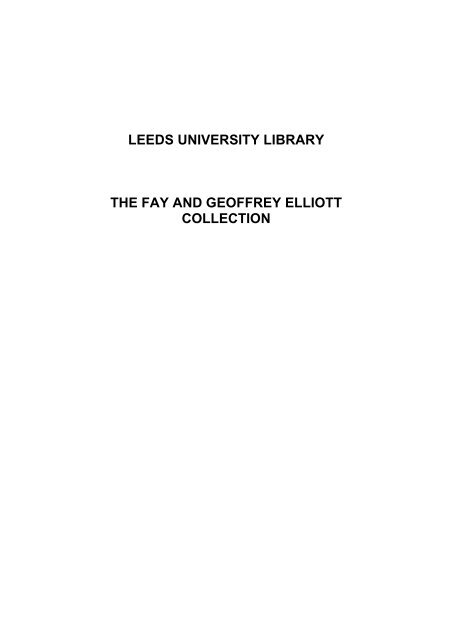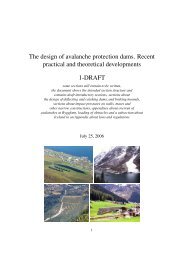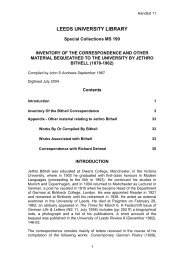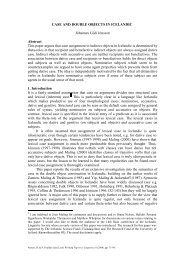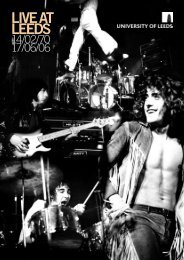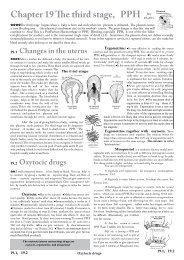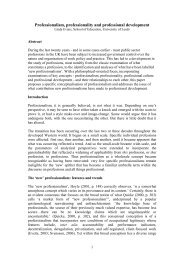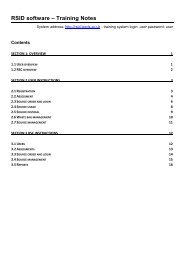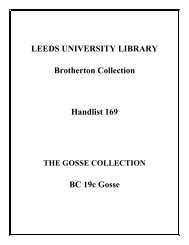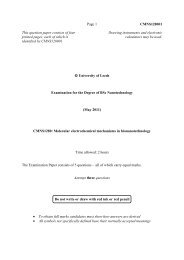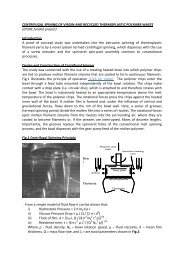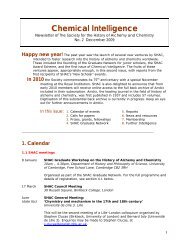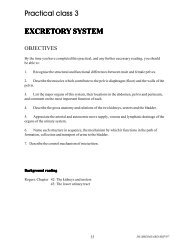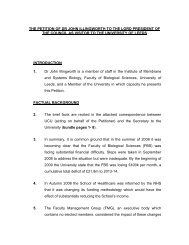This handlist records the contents of the Fay and Geoffrey Elliott ...
This handlist records the contents of the Fay and Geoffrey Elliott ...
This handlist records the contents of the Fay and Geoffrey Elliott ...
Create successful ePaper yourself
Turn your PDF publications into a flip-book with our unique Google optimized e-Paper software.
LEEDS UNIVERSITY LIBRARY<br />
THE FAY AND GEOFFREY ELLIOTT<br />
COLLECTION
THE FAY AND GEOFFREY ELLIOTT COLLECTION<br />
1. OSCAR WILDE AND HIS CONTEMPORARIES<br />
Aubrey BEARDSLEY (1872-98)<br />
H<strong>and</strong>list 148<br />
BEARDSLEY, Aubrey Autograph letter to George Scotson-Clark. 11 Lombard<br />
St, EC, [1892].<br />
<strong>This</strong> early letter from Beardsley to his school-friend Scotson-Clark<br />
quotes a letter he has received from Edward Burne-Jones advising him<br />
about education for a career as an artist. A playful illustration in <strong>the</strong> text<br />
shows a man, evidently Beardsley himself, climbing <strong>the</strong> dark side <strong>of</strong> a<br />
mountain beyond which lies <strong>the</strong> sunny valley "Art".<br />
MALORY, Sir Thomas Le mort darthur. London: J.M. Dent, 1893-4. In 12<br />
parts as issued, illustrated by Aubrey Beardsley.<br />
Beardsley's illustrations for this work, some 600 in number, represent<br />
his first major commission as an illustrator <strong>of</strong> books.<br />
BEARDSLEY, Aubrey Pro<strong>of</strong> copies in red <strong>of</strong> two grotesques from <strong>the</strong> Bon-<br />
Mots series. 1893.<br />
Concerned that Beardsley would become bored with <strong>the</strong> discipline <strong>of</strong><br />
providing so many illustrations for <strong>the</strong> Mort darthur, Dent also<br />
commissioned him to produce bizarre images to decorate, ra<strong>the</strong>r than<br />
directly illustrate, a series <strong>of</strong> small editions <strong>of</strong> <strong>the</strong> sayings <strong>and</strong> writings<br />
<strong>of</strong> English wits from Sheridan to Sydney Smith. These two examples<br />
are on a single leaf <strong>of</strong> Japanese vellum inscribed on <strong>the</strong> verso: "<strong>This</strong><br />
first issue <strong>of</strong> 2 sketches by Aubrey Beardsley is limited to 25 copies in<br />
black ink <strong>and</strong> 10 copies in Red ink. No 10. Leonard Smi<strong>the</strong>rs".<br />
LUCIAN Lucian’s True history. Translated by Francis Hickes, illustrated by<br />
William Strang, J.B. Clark & Aubrey Beardsley. London: privately printed,<br />
1894.<br />
Beardsley described his drawings for Lucian as "<strong>the</strong> most extraordinary<br />
things that have ever appeared in a book … also <strong>the</strong> most indecent."<br />
<strong>This</strong> copy, number 44 <strong>of</strong> 54 De Luxe copies printed on Japanese<br />
vellum, contains <strong>the</strong> suppressed plate <strong>of</strong> 'A Snare <strong>of</strong> Vintage' loosely<br />
inserted.<br />
1
H<strong>and</strong>list 148<br />
BEARDSLEY, Aubrey Invitation card for <strong>the</strong> opening <strong>of</strong> <strong>the</strong> Prince's Ladies<br />
Golf Club. [Mitcham], 1894.<br />
The card depicts two women golfers <strong>and</strong> Pierrot as <strong>the</strong>ir caddie.<br />
BEARDSLEY, Aubrey Drawing entitled “La dame aux camélias” executed on<br />
a preliminary blank leaf <strong>of</strong> La dame aux camélias by Alex<strong>and</strong>re Dumas fils,<br />
nouvelle édition, Paris, Calmann Lévy, 1895.<br />
The book has a presentation inscription to Beardsley from Dumas, 13<br />
July 1895, written some four months before <strong>the</strong> author’s death.<br />
Beardsley visited him at Puy, accompanied by Arthur Symons, <strong>and</strong> <strong>the</strong><br />
artist <strong>and</strong> <strong>the</strong> novelist achieved remarkable rapport. Beardsley’s<br />
drawing <strong>of</strong> <strong>the</strong> heroine, added in 1897, is in pencil with camellias<br />
highlighted in pink watercolour <strong>and</strong> shows an uncharacteristically<br />
relaxed style, perhaps influenced by Charles Conder.<br />
Keynotes series <strong>of</strong> novels <strong>and</strong> short stories. Twenty-one designs by Aubrey<br />
Beardsley. With press notices. London: John Lane, 1896.<br />
A pamphlet advertising Lane's Keynote series illustrated by Beardsley,<br />
with <strong>the</strong> manuscript inscription "Counter" on <strong>the</strong> front wrapper.<br />
SYMONS, Arthur Aubrey Beardsley. London: At <strong>the</strong> Sign <strong>of</strong> <strong>the</strong> Unicorn,<br />
1898.<br />
with:<br />
BEARDSLEY, Aubrey Autograph letter to Leonard Smi<strong>the</strong>rs. Crowborough, [9<br />
June 1896].<br />
In his letter, dated from <strong>the</strong> postmark, Beardsley reports to <strong>the</strong><br />
publisher Smi<strong>the</strong>rs that "The cough still lingers on, but generally<br />
speaking I am already much stronger"; he asks to be sent Shelley's<br />
poems <strong>and</strong> Ma<strong>the</strong>w Arnold's selections from Wordsworth, <strong>and</strong> he says<br />
"I shall start drawing again very soon." The letter's postscript reads<br />
"Love to Symons", who was editor <strong>of</strong> The Savoy <strong>and</strong> author <strong>of</strong> this first<br />
study <strong>of</strong> Beardsley to be published in book form.<br />
HAWKER, W.J. Photograph <strong>of</strong> Aubrey Beardsley. Bournemouth, [1897].<br />
The studio photograph shows a pensive seated Beardsley in a very<br />
thick tweed suit. It is signed <strong>and</strong> inscribed at <strong>the</strong> foot: "For Mrs Burleigh<br />
from Aubrey Beardsley" <strong>and</strong> signed by <strong>the</strong> photographer on <strong>the</strong> verso:<br />
"W.J. Hawker, Bournemouth".<br />
2
BEARDSLEY, Ellen Autograph letter to J.M. Dent. Mentone, [1898].<br />
with:<br />
DENT, J.M. Autograph letter to Ellen Beardsley from J.M. Dent. Aldine<br />
House, 19 Great Eastern Street, 9 September 1896.<br />
<strong>and</strong>:<br />
HARLAND, Henry Autograph letter to J.M. Dent. Cromwell Road, S.W.,<br />
[undated].<br />
H<strong>and</strong>list 148<br />
Ellen Beardsley's anguished letter is undated, but clearly was written<br />
very shortly before her son's death. The letter to her some 18 months<br />
earlier from Dent, who had given Aubrey Beardsley his first major<br />
commission as an illustrator, expresses concern about his deepening<br />
illness <strong>the</strong>n, while <strong>the</strong> letter from Harl<strong>and</strong>, first editor <strong>of</strong> The yellow book<br />
<strong>and</strong> also consumptive, asks Dent to contribute to a fund for Beardsley's<br />
mo<strong>the</strong>r <strong>and</strong> sister following his death.<br />
BEARDSLEY, Aubrey The early work <strong>of</strong> Aubrey Beardsley. Prefatory note by<br />
H.C. Marillier, full plate illustrations. London: John Lane, The Bodley Head,<br />
1899.<br />
BEARDSLEY, Aubrey The later work <strong>of</strong> Aubrey Beardsley. Prefatory note by<br />
H.C. Marillier. London: John Lane, The Bodley Head, 1901.<br />
BEARDSLEY, Aubrey The uncollected work <strong>of</strong> Aubrey Beardsley.<br />
Introduction by C. Lewis Hind. London: John Lane, The Bodley Head, 1925.<br />
The earlier two volumes are limited editions on Japanese vellum<br />
Past <strong>and</strong> present. The magazine <strong>of</strong> <strong>the</strong> Brighton Grammar School.<br />
E.J.Marshall Memorial Number. December 1900.<br />
<strong>This</strong> special issue <strong>of</strong> Beardsley's school magazine, honouring its longserving,<br />
recently deceased headmaster (who had come to disapprove<br />
strongly <strong>of</strong> his former pupil's work), reproduces five <strong>of</strong> Beardsley's<br />
drawings from 1888 which give no obvious suggestion <strong>of</strong> how his<br />
mature style would develop.<br />
BEARDSLEY, Aubrey The story <strong>of</strong> Venus <strong>and</strong> Tannhauser. A romantic novel.<br />
London: for private circulation, 1907.<br />
Number 43 <strong>of</strong> 50 copies printed on Japanese vellum, this is <strong>the</strong> first<br />
appearance <strong>of</strong> a full text <strong>of</strong> Beardsley's novel; an expurgated<br />
portion <strong>of</strong> it was printed in The Savoy during his lifetime, with <strong>the</strong><br />
title Under <strong>the</strong> Hill.<br />
3
Max BEERBOHM (1872-1956)<br />
H<strong>and</strong>list 148<br />
BEERBOHM, Sir Max The works <strong>of</strong> Max Beerbohm. With a bibliography by<br />
John Lane. London: John Lane. The Bodley Head; New York: Charles<br />
Scribner's Sons, 1896.<br />
with:<br />
BEERBOHM, Sir Max Autograph card to Ada Leverson Villino Chiaro,<br />
Rapallo, [undated].<br />
A presentation copy <strong>of</strong> <strong>the</strong> twenty-three-year-old Max Beerbohm's<br />
Works, inscribed by him "To Ernest <strong>and</strong> Ada Leverson from Max, June<br />
'96", Wilde's loyal friends. The inserted card from Max to Ada Leverson<br />
looks forward to her visit to eat with him, Sacheverell <strong>and</strong> Wyndham at<br />
Villino Chiaro, Rapallo, Beerbohm’s home from 1910 until his death.<br />
Ernest DOWSON 1867-1900<br />
DOWSON, Ernest Decorations: in verse <strong>and</strong> prose. London: Leonard<br />
Smi<strong>the</strong>rs, 1899.<br />
An extensive manuscript account <strong>of</strong> Dowson's last days <strong>and</strong> his death<br />
is written by Robert H. Sherard on both sides <strong>of</strong> <strong>the</strong> front free<br />
endpaper, dated 17 January 1904. The destitute Dowson was cared<br />
for during his final illness by Sherard <strong>and</strong> his wife, who were almost as<br />
impoverished <strong>the</strong>mselves.<br />
Ronald FIRBANK (1886-1926)<br />
FIRBANK, Ronald Autograph manuscript <strong>of</strong> <strong>the</strong> poem 'The Wind & The<br />
Roses'. c.1904<br />
The manuscript is accompanied by The wind <strong>and</strong> <strong>the</strong> roses, with an<br />
introduction by Miriam J. Benkovitz. [London]: Privately printed for A.<br />
Clodd, 1965. Number 3 from a limited edition <strong>of</strong> 50 copies printed at <strong>the</strong><br />
John Roberts Press.<br />
JOHNSON, Lionel (1867-1902)<br />
***JOHNSON, Lionel Poems. London :Elkin Ma<strong>the</strong>ws, Boston : Copel<strong>and</strong> &<br />
Day, 1895<br />
With Johnson's autograph manuscript corrections on seven pages <strong>and</strong><br />
his presentation inscription to Walter Alison Phillips (1864-1950),<br />
dedicatee <strong>of</strong> <strong>the</strong> poem 'Hawthorne' which is printed on pages 43 to 44.<br />
Bookplate <strong>of</strong> H. Bradley Martin, <strong>and</strong> book-label <strong>of</strong> J.O. Edwards.<br />
4
Richard LE GALLIENNE (1866-1947)<br />
H<strong>and</strong>list 148<br />
LE GALLIENNE, Richard Typed letter signed to F.J. Dearden. Woodstock,<br />
New York, 3 December 1923.<br />
with:<br />
DEARDEN, F.J. Incomplete draft autograph letter. [undated.]<br />
The body <strong>of</strong> Le Gallienne's letter is in duplicated typescript with<br />
Dearden's name <strong>and</strong> address added later; it invites subscription to <strong>the</strong><br />
Patron's Edition <strong>of</strong> <strong>the</strong> works <strong>of</strong> Oscar Wilde, a printed advertisement<br />
for which is also enclosed. Dearden's draft reply, unsigned, sets out<br />
<strong>the</strong> terms on which he was proposing to accept <strong>the</strong> invitation to<br />
subscribe.<br />
RICKETTS, Charles (1866-1931)<br />
RICKETTS, Charles Beyond <strong>the</strong> Threshold. By Jean Paul Raymond [i.e.<br />
Charles Ricketts]. Plaistow: privately printed [at <strong>the</strong> Curwen Press], 1929.<br />
with:<br />
RICKETTS, Charles Autograph letter to A.J.A. Symons, Townshend House,<br />
undated, with a preliminary pen <strong>and</strong> ink sketch in blue for <strong>the</strong> drawing which<br />
appears opposite page 10 <strong>of</strong> <strong>the</strong> book.<br />
Ricketts's pseudonymous work, issued in 150 copies, is bound to his<br />
own elaborately decorated design, signed CR at <strong>the</strong> foot <strong>of</strong> both <strong>the</strong><br />
front <strong>and</strong> back cover. His presentation inscription reads: "To. AJ<br />
Symons The. Onlie. Begetter. <strong>of</strong>. this. Beautious. Book. The Autor[sic]-<br />
Adventurer C Ricketts 1930". The letter comments on <strong>the</strong> inscription<br />
<strong>and</strong> Ricketts's next book The transit <strong>of</strong> <strong>the</strong> gods.<br />
Frederick ROLFE (Baron Corvo) (1860-1913)<br />
ROLFE, Frederick Autograph manuscript commonplace book. c. 1900<br />
The commonplace book <strong>of</strong> 316 pages, densely written, chiefly on<br />
rectos only, is a publisher's dummy volume, bound in worn red<br />
buckram with <strong>the</strong> remains <strong>of</strong> Rolfe's Corvine seal on <strong>the</strong> front cover. It<br />
was evidently compiled by Rolfe when writing his novel Hadrian VII,<br />
published in 1904, <strong>and</strong> corresponds in content <strong>and</strong> appearance to <strong>the</strong><br />
commonplace book described at <strong>the</strong> opening <strong>of</strong> <strong>the</strong> novel, belonging to<br />
its protagonist George Arthur Rose. Some <strong>of</strong> <strong>the</strong> manuscript's <strong>contents</strong><br />
constitute a quarry for <strong>the</strong> novel, but many o<strong>the</strong>r quotations,<br />
speculations <strong>and</strong> references to contemporary events <strong>and</strong> individuals<br />
are included.<br />
5
H<strong>and</strong>list 148<br />
ROLFE, Frederick Don Tarquinio Autograph manuscript <strong>of</strong> a revised version<br />
<strong>of</strong> <strong>the</strong> novel, [1904].<br />
The unpublished manuscript is a lightly corrected fair copy, bound in<br />
original white buckram illustrated with a picture <strong>of</strong> <strong>the</strong> eponymous hero.<br />
The story <strong>of</strong> one day in <strong>the</strong> life <strong>of</strong> a Renaissance Italian artist, originally<br />
written entirely as <strong>of</strong> that period, it is presented in this version by a<br />
fictional twentieth-century narrator, a device that Rolfe mistakenly<br />
assumed would make <strong>the</strong> work more attractive to publishers. In <strong>the</strong><br />
event, Chatto & Windus undertook to publish <strong>the</strong> earlier unmodified<br />
version.<br />
ROLFE, Frederick Don Tarquinio. A kataleptic phantasmatic romance.<br />
London: Chatto & Windus, 1905.<br />
<strong>This</strong> is <strong>the</strong> dedication copy <strong>of</strong> <strong>the</strong> published version <strong>of</strong> Rolfe's novel.<br />
inscribed by <strong>the</strong> author to his bro<strong>the</strong>r Herbert on <strong>the</strong> day <strong>of</strong> publication:<br />
"Amato Amabili H.R. dedit Amans R. xviii May 1905". With <strong>the</strong><br />
bookplate <strong>of</strong> H. Bradley Martin.<br />
ROLFE, Frederick A letter to Fa<strong>the</strong>r Beauclerk. Edinburgh: Tragara Press,<br />
1960.<br />
with:<br />
ROLFE, Frederick Autograph letter to Fa<strong>the</strong>r Sidney de Vere Beauclerk.<br />
Jesus College, Oxford, 10 February 1906.<br />
Rolfe's great capacity for biting h<strong>and</strong>s that fed him is seen in this letter<br />
to Fr. Beauclerk, custodian <strong>of</strong> St Winifride's miraculous well at Holywell,<br />
near Flint. His attempt to give Rolfe employment ended, after years <strong>of</strong><br />
dispute, in Beauclerk's dismissal from his own post. The printed version<br />
<strong>of</strong> <strong>the</strong> letter is number 10 <strong>of</strong> 20 copies printed for private distribution.<br />
ROLFE, Frederick The bull against <strong>the</strong> enemy <strong>of</strong> <strong>the</strong> Anglican race. London:<br />
printed for A.J.A. Symons at <strong>the</strong> Curwen Press, 1929.<br />
One <strong>of</strong> 50 copies printed <strong>of</strong> an attack on Lord Northcliffe <strong>and</strong> <strong>the</strong> Daily<br />
Mail, "Distributed privately on 27th June 1929 at <strong>the</strong> first dinner held by<br />
<strong>the</strong> Corvine Society, at <strong>the</strong> Ambassador Club, London."<br />
ROLFE, Frederick Reviews <strong>of</strong> unwritten books. 4 vols. Edinburgh: Tragara<br />
Press, 1985-88.<br />
Each <strong>of</strong> <strong>the</strong> separately published volumes, collecting Rolfe's reviews <strong>of</strong><br />
imaginary works originally written for <strong>the</strong> Monthly review, is one <strong>of</strong> 120<br />
or fewer copies printed,. The copies <strong>of</strong> <strong>of</strong> <strong>the</strong> third <strong>and</strong> fourth<br />
collections are inscribed to Ge<strong>of</strong>frey <strong>Elliott</strong> by <strong>the</strong> editor Donald Weeks.<br />
6
H<strong>and</strong>list 148<br />
SYMONS, A.J.A. The quest for Corvo : an experiment in biography. London :<br />
Cassell, 1934<br />
With <strong>the</strong> bookplate <strong>of</strong> <strong>the</strong> author.<br />
John RUSKIN (1818-1900)<br />
RUSKIN, John The seven lamps <strong>of</strong> architecture. London: Smith, Elder,1849.<br />
In common with <strong>the</strong> items that follow, <strong>the</strong> volumes are h<strong>and</strong>somely<br />
bound in crimson morocco by Bedford <strong>and</strong> have <strong>the</strong> bookplates <strong>of</strong><br />
George Gurney <strong>and</strong> Estelle Doheny. In addition, <strong>the</strong> volume has<br />
Charles Dickens's lion bookplate <strong>and</strong> <strong>the</strong> Gadshill Place library sale<br />
ticket<br />
RUSKIN, John The stones <strong>of</strong> Venice. Three volumes. London: Smith, Elder,<br />
1851-1853.<br />
In addition to <strong>the</strong> Gurney, Doheny <strong>and</strong> Dickens bookplates in all<br />
volumes, <strong>the</strong> first volume is inscribed by Ruskin: "Charles Dickens,<br />
Esq. With <strong>the</strong> author's grateful regards."<br />
RUSKIN, John Modern painters. Five volumes. London: Smith, Elder, 1856-<br />
1860.<br />
Each volume has <strong>the</strong> Gurney <strong>and</strong> Doheny bookplates.<br />
RUSKIN, John Seven autograph letters, one incomplete, to his fa<strong>the</strong>r John<br />
James Ruskin. Bar-le-Duc; Lauffenbourg; Zug; Turin, 16 May - 4 August<br />
1858.<br />
Each letter in <strong>the</strong> series, written during one <strong>of</strong> Ruskin’s frequent<br />
European tours, incorporates a small ink sketch illustrating a scene<br />
described in <strong>the</strong> text. Mounted in an album with <strong>the</strong> bookplate <strong>of</strong> Doris<br />
L. Benz.<br />
RUSKIN, John The two paths: being lectures on art, <strong>and</strong> its application to<br />
decoration <strong>and</strong> manufacture. Delivered in 1858-9. London: Smith Elder 1859,<br />
In <strong>the</strong> original purple-brown cloth by Westleys, with <strong>the</strong>ir binder's ticket<br />
on <strong>the</strong> rear endpaper, this is Carlyle's copy, with his bookplate <strong>and</strong> <strong>the</strong><br />
author's autograph inscription: "Thomas Carlyle. With John Ruskin's<br />
affectionate regards, 1859"<br />
7
H<strong>and</strong>list 148<br />
RUSKIN, John Notes on some <strong>of</strong> <strong>the</strong> principal pictures exhibited in <strong>the</strong> rooms<br />
<strong>of</strong> <strong>the</strong> Royal Academy: 1875. Orpington: George Allen, [London]: Ellis <strong>and</strong><br />
White, 1875.<br />
<strong>This</strong> copy in <strong>the</strong> original printed wrappers with a blue cloth backstrip is<br />
inscribed by Ruskin on <strong>the</strong> front cover "Thomas Carlyle with <strong>the</strong><br />
authors constant love June 4th, 1875". The text is annotated in pencil<br />
by Carlyle, chiefly supplying <strong>the</strong> names <strong>of</strong> artists who have been<br />
mentioned anonymously.<br />
A.J.A. SYMONS (1900-41)<br />
SYMONS, A.J.A. Emin <strong>the</strong> Governor <strong>of</strong> Equatoria. London: The Fleuron Ltd.,<br />
1928.<br />
with:<br />
PYE, Sybil Autograph letter to A.J.A. Symons. Newick, 2 June 1935.<br />
The author’s own copy, bound for him by Sybil Pye in purple morocco<br />
with full-depth lea<strong>the</strong>r inlays <strong>of</strong> brown, blue <strong>and</strong> orange <strong>and</strong> complex<br />
patterns <strong>of</strong> gilt rules. In her letter about <strong>the</strong> binding, Pye says: "The<br />
subject, as you will agree, allowed one to use rich & tropical colours, &<br />
I have had a lot <strong>of</strong> fun over <strong>the</strong> job. I hope you will feel <strong>the</strong> result<br />
justifies <strong>the</strong> fun." She goes on to ask if Symons will lend <strong>the</strong> book to an<br />
exhibition <strong>of</strong> Arts & Crafts being organized by Douglas Cockerell, who<br />
with Ricketts greatly influenced her self-taught work<br />
Paul VERLAINE (1844-96)<br />
VERLAINE, Paul Liturgies intimes. Paris: Bibliothéque du Saint-Graal, 1892.<br />
The copy, in brown morocco with <strong>the</strong> original wrappers bound in, is<br />
inscribed by <strong>the</strong> author on <strong>the</strong> half-title "à Pierre Louys. Paul Verlaine"<br />
<strong>and</strong> <strong>the</strong> inscription is continued "et Oscar Wilde" in Wilde's h<strong>and</strong>.<br />
James WHISTLER (1834-1903)<br />
WHISTLER, James Autograph letter to Luke Ionides. Hotel du Bras d’Or,<br />
Trouville, Calvados, France, 20 October 1865.<br />
Whistler tells his early patron Ionides about his work at Trouville with<br />
Courbet <strong>and</strong> asks for an advance <strong>of</strong> £50 to be paid to Farmer <strong>and</strong><br />
Rogers Oriental Warehouse, Regent Street, on his behalf, probably for<br />
additions to Whistler's collection <strong>of</strong> porcelain.<br />
8
Oscar WILDE (1854-1900)<br />
H<strong>and</strong>list 148<br />
WILDE, Oscar Kottabos. Trinity College, Dublin. Vol. 3, nos, 2, 6 <strong>and</strong> 8.<br />
Dublin; London; Oxford; Cambridge, 1877-79.<br />
Each issue includes a poem by <strong>the</strong> undergraduate Wilde, successively<br />
'Wasted days', ' La belle Marguerite' <strong>and</strong> 'Ave! Maria'.<br />
WILDE, Oscar Ravenna. Recited in <strong>the</strong> Theatre, Oxford, June 26, 1878.<br />
Oxford: Thos. Shrimpton <strong>and</strong> Son, 1878.<br />
Wilde's first book, his successful entry in <strong>the</strong> Newdigate Prize<br />
competition for 1878, here in its original grey printed wrappers. Having<br />
visited Ravenna a year before its announcement as <strong>the</strong> prescribed<br />
Newdigate topic, he wrote <strong>the</strong> poem swiftly, including adapted lines<br />
from earlier poems <strong>of</strong> his own.<br />
WILDE, Oscar Autograph letter to Marian Willets ("Miss Willett"). Magdalen<br />
College, Oxford, "Thursday", [1878].<br />
Marian Fitzgerald Willets was stepdaughter <strong>of</strong> James Legge, <strong>the</strong> first<br />
Pr<strong>of</strong>essor <strong>of</strong> Chinese at Oxford. The letter to her was originally sent<br />
with a photograph (no longer present) <strong>of</strong> a Burne-Jones watercolour<br />
called 'Hope, 'owned by Wilde. Wilde comments: "In so many <strong>of</strong> Burne-<br />
Jones' pictures we have merely <strong>the</strong> pagan worship <strong>of</strong> beauty: but in this<br />
one I seem to see more humanity <strong>and</strong> sympathy than in all <strong>the</strong> o<strong>the</strong>rs".<br />
WILDE, Oscar Poems. Fifth edition. London : David Bogue, 1882.<br />
Wilde's Poems was first published in 1881, three textually-identical<br />
'editions', each <strong>of</strong> 250 copies, successively being issued by Bogue in<br />
that year. The volume was reprinted, with alterations, as <strong>the</strong> fourth <strong>and</strong><br />
fifth editions in early 1882. <strong>This</strong> copy has Wilde's signed presentation<br />
inscription to Otho Holl<strong>and</strong> Lloyd, his bro<strong>the</strong>r-in-law (<strong>and</strong> fa<strong>the</strong>r <strong>of</strong> <strong>the</strong><br />
Dadaist hero Arthur Cravan, who claimed to have seen <strong>the</strong> long-dead<br />
Wilde alive in 1913, five years before his own mysterious<br />
disappearance).<br />
WILDE, Oscar Autograph manuscript notes for a lecture on art <strong>and</strong><br />
craftsmanship. [Philadelphia, 1882.]<br />
The notes, drafted in purple crayon on seven sheets <strong>of</strong> <strong>the</strong> headed<br />
stationery <strong>of</strong> Wilde’s American publisher J.M. Stoddart & Co, relate to<br />
one <strong>of</strong> <strong>the</strong> lectures delivered on his extensive lecture tour <strong>of</strong> <strong>the</strong> United<br />
states in 1882. The notes convey <strong>the</strong> hectic, improvisatory way in<br />
which Wilde was obliged to work during <strong>the</strong> extraordinarily dem<strong>and</strong>ing<br />
tour.<br />
9
H<strong>and</strong>list 148<br />
STODDART, J.M., & CO. Manuscript draft <strong>and</strong> notes for <strong>the</strong> original contract<br />
with Oscar Wilde for publishing Rose leaf <strong>and</strong> apple leaf <strong>and</strong> for Wilde's<br />
introduction to <strong>the</strong> work, [1882].<br />
WILDE, Oscar ‘L'envoi’. Autograph manuscript <strong>of</strong> <strong>the</strong> introductory essay to<br />
Rennell Rodd's Rose leaf <strong>and</strong> apple leaf, 1882.<br />
RODD, Rennell Rose leaf <strong>and</strong> apple leaf. With an introduction by Oscar<br />
Wilde. Philadelphia: J.M. Stoddart & Co., 1882.<br />
STODDART, J.M., & CO. Manuscript draft receipt "for Mr Wilde to sign" for<br />
<strong>the</strong> publishing rights to his two poems 'Le jardin' <strong>and</strong> 'La mer'.<br />
When leaving for his lecture tour <strong>of</strong> America, Wilde took with him a<br />
copy <strong>of</strong> Songs in <strong>the</strong> south, a collection <strong>of</strong> poems by his Oxford friend<br />
Rennell Rodd, for which he agreed to seek an American publisher.<br />
Having arranged publication <strong>of</strong> <strong>the</strong> work with J.M. Stoddart under a<br />
new title, Wilde wrote 'L'envoi' as an introduction for it. In due course<br />
Rodd, who was starting his career in <strong>the</strong> Foreign Office, was worried by<br />
being associated with what was essentially a personal <strong>and</strong><br />
controversial aes<strong>the</strong>tic testament <strong>of</strong> Wilde's alone <strong>and</strong> <strong>the</strong>ir friendship<br />
ceased. The book is one <strong>of</strong> 175 copies printed on h<strong>and</strong>made paper in<br />
maroon ink on rectos only, interleaved throughout with pale applegreen<br />
tissue; <strong>the</strong> original parchment covers are decorated with a<br />
reproduction <strong>of</strong> Wilde's seal on <strong>the</strong> front cover, emphasising his<br />
proprietory interest. The contract for publishing Rodd's book with<br />
Wilde's introduction <strong>and</strong> <strong>the</strong> receipt for rights to two Wilde poems are<br />
both drafted on Stoddart's printed stationery.<br />
WILDE, Oscar The Duchess <strong>of</strong> Padua. Autograph manuscript, 1883.<br />
Wilde's second play was written for <strong>the</strong> American actress Mary<br />
Anderson, who <strong>the</strong>n declined to perform in it; it was eventually<br />
produced in New York in 1891, but did not transfer to <strong>the</strong> London<br />
stage. The manuscript is written on <strong>the</strong> rectos only <strong>of</strong> 228 leaves, with<br />
corrections to <strong>the</strong> text throughout. On completing it, Wilde said "I have<br />
no hesitation in saying that it is <strong>the</strong> masterpiece <strong>of</strong> all my literary work,<br />
<strong>the</strong> chef-d'oeuvre <strong>of</strong> my youth", but by 1898 he judged that "The<br />
Duchess is unfit for publication". There had in fact been a privately<br />
printed first edition <strong>of</strong> 20 prompt copies in March 1883 <strong>and</strong> <strong>the</strong><br />
presence <strong>of</strong> printers' marks, including <strong>the</strong> note "20 copies" in pencil on<br />
<strong>the</strong> title-page, <strong>and</strong> <strong>the</strong> precise correlation <strong>of</strong> <strong>the</strong> author's corrections<br />
with <strong>the</strong> printed text, suggest that this manuscript was used for its<br />
setting. The play was to appear more conspicuously in <strong>the</strong> posthumous<br />
Collected Edition <strong>of</strong> Wilde's works in 1908.<br />
10
H<strong>and</strong>list 148<br />
WILDE, Oscar Autograph manuscript drafts <strong>of</strong> six aphorisms, with revisions<br />
<strong>and</strong> deletions. [Early 1890s]<br />
The six aphoristic paradoxes are written on a single foolscap page, <strong>the</strong><br />
second being entirely deleted (but legible) <strong>and</strong> three o<strong>the</strong>rs being<br />
revised. The fifth appears in 'Phrases <strong>and</strong> philosophies for <strong>the</strong> use <strong>of</strong><br />
<strong>the</strong> young' (1894) <strong>and</strong> <strong>the</strong> sixth, in modified form, in The picture <strong>of</strong><br />
Dorian Gray (1891).<br />
WILDE, Oscar 'The picture <strong>of</strong> Dorian Gray.' Lippincott's monthly magazine,<br />
no.46, July 1890. (London: Ward, Lock & Co.)<br />
J.M. Stoddart, <strong>the</strong> editor <strong>of</strong> Lippincott's, inaugurated its English edition<br />
in 1899 <strong>and</strong> was delighted to secure <strong>the</strong> first appearance <strong>of</strong> Wilde's<br />
novel for <strong>the</strong> magazine, published simultaneously in London <strong>and</strong><br />
Philadelphia. <strong>This</strong> copy, in lea<strong>the</strong>r-backed cloth with <strong>the</strong> original<br />
wrappers bound in, later owned by Lord Birkenhead, is inscribed: "<strong>This</strong><br />
is now one <strong>of</strong> <strong>the</strong> rarest <strong>of</strong> all Wilde editions. Robert Ross. 30/4/18."<br />
The version differs substantially from that <strong>of</strong> <strong>the</strong> first book edition <strong>of</strong><br />
1891.<br />
WILDE, Oscar Poems. London: Elkin Ma<strong>the</strong>ws & John Lane, 1892.<br />
One <strong>of</strong> 220 numbered copies signed at <strong>the</strong> colophon by Wilde, <strong>the</strong><br />
Author's Edition. These copies were in fact made up <strong>of</strong> <strong>the</strong> stock <strong>of</strong> <strong>the</strong><br />
fifth edition (1882) <strong>of</strong> <strong>the</strong> Poems <strong>of</strong> 1881 remaining after <strong>the</strong> bankruptcy<br />
<strong>of</strong> <strong>the</strong> previous publisher Bogue. A new title-page was provided by<br />
Charles Ricketts, who also designed <strong>the</strong> decoration <strong>of</strong> <strong>the</strong> lilac cloth<br />
binding.<br />
WILDE, Oscar Salomé. Drame en un acte. Paris: Librairie de l'Art<br />
Indépendent; London: Elkin Ma<strong>the</strong>ws et John Lane, 1893.<br />
One <strong>of</strong> <strong>the</strong> 600 copies <strong>of</strong> <strong>the</strong> first edition, published in French with a<br />
title-page design by Félicien Rops. The original purple wrappers are<br />
retained inside <strong>the</strong> morocco binding by <strong>the</strong> Adams Bindery. Ma<strong>the</strong>ws<br />
<strong>and</strong> Lane first issued <strong>the</strong> English translation with illustrations by Aubrey<br />
Beardsley a year later.<br />
WILDE, Oscar The sphinx. London: Elkin Ma<strong>the</strong>ws <strong>and</strong> John Lane, 1894.<br />
with:<br />
WILDE, Oscar Original manuscript contract for publication <strong>of</strong> The sphinx.<br />
Drawn up by Markby,Wilde & Johnson, 9 Lincoln's Inn. [July] 1892.<br />
Illustrated with 10 wood engravings by Charles Ricketts, who also<br />
decorated <strong>the</strong> publisher's vellum binding, this is one <strong>of</strong> 200 copies<br />
printed in three colours - <strong>and</strong> in capital letters throughout - at <strong>the</strong><br />
Ballantyne Press. The contract is signed by Wilde, Ricketts, Ma<strong>the</strong>ws<br />
11
H<strong>and</strong>list 148<br />
<strong>and</strong> Lane, witnessed by Charles Shannon <strong>and</strong> Edward Shelley (whose<br />
personal relationship with Wilde was later examined in <strong>the</strong> Law Courts);<br />
<strong>the</strong> contract has autograph revisions by Oscar Wilde throughout,<br />
including <strong>the</strong> regular substitution <strong>of</strong> "poet" for "author".<br />
WILDE, Oscar A woman <strong>of</strong> no importance. London: John Lane at <strong>the</strong> Sign <strong>of</strong><br />
<strong>the</strong> Bodley Head, 1894.<br />
One <strong>of</strong> 50 large-paper copies, printed on h<strong>and</strong>made paper. The beige<br />
buckram cover <strong>and</strong> spine are decorated with gilt designs by Charles<br />
Shannon.<br />
WILDE, Oscar "Phrases <strong>and</strong> philosophies for <strong>the</strong> use <strong>of</strong> <strong>the</strong> young" in The<br />
Chameleon, volume 1, number 1. London: Gay <strong>and</strong> Bird, December 1894.<br />
With<br />
***WILDE, Oscar Autograph manuscript drafts <strong>of</strong> five aphorisms. [Early<br />
1890s]<br />
<strong>and</strong><br />
Nicholson, John Gambril Autograph manuscript poem “Sonnet CLIV”, signed<br />
<strong>and</strong> dated Jan. 4 th , 1893 from 7 Nelson St., Lower Broughton, Manchester<br />
Wilde contributed his thirty-five “Phrases <strong>and</strong> philosophies” at Lord<br />
Alfred Douglas’s request to <strong>the</strong> first <strong>and</strong> only issue <strong>of</strong> The Chameleon,<br />
an Oxford undergraduate magazine provocatively celebrating<br />
homosexual relations. The manuscript aphorisms have evidently been<br />
preserved with this copy <strong>of</strong> <strong>the</strong> magazine (which is number 100 <strong>of</strong> <strong>the</strong><br />
one hundred copies printed) for many years, although none is<br />
published in it, nor apparently elsewhere. John Gambril Nicholson,<br />
author <strong>of</strong> <strong>the</strong> manuscript sonnet present <strong>and</strong> ano<strong>the</strong>r contributor to <strong>the</strong><br />
magazine, was already known as <strong>the</strong> editor <strong>of</strong> <strong>the</strong> notorious Uranian<br />
poetry anthology Love in earnest (1892), <strong>the</strong> punning title <strong>of</strong> which<br />
looks forward to that <strong>of</strong> Wilde’s most famous play. Wilde soon bitterly<br />
regretted his association with The Chameleon when he was unjustly<br />
presented at his trial as <strong>the</strong> corrupting prime-mover behind a magazine<br />
to which he had casually contributed out <strong>of</strong> ill-judged kindness.<br />
WILDE, Oscar Autograph letter to Robert Ross. Hotel de l’Europe, Algiers,<br />
[c.25 Jan 1895].<br />
The letter refers to Wilde's illicit pleasures during his visit to Algiers with<br />
Lord Alfred Douglas while rehearsals for The importance <strong>of</strong> being<br />
earnest proceeded in London.<br />
12
H<strong>and</strong>list 148<br />
WILDE, Oscar The ballad <strong>of</strong> Reading Gaol. By C.3.3. London: Leonard<br />
Smi<strong>the</strong>rs, 1898.<br />
Number 70 <strong>of</strong> 99 copies printed in March 1898, a month after <strong>the</strong><br />
work's highly-successful first publication; it is numbered in purple ink by<br />
Smi<strong>the</strong>rs <strong>and</strong> signed in black ink by Wilde, who authorised it to be<br />
advertised as <strong>the</strong> Author's Edition. The cover design is by Chares<br />
Ricketts. Wilde's authorship was not indicated in print in <strong>the</strong> work until<br />
June 1899.<br />
WILDE, Oscar An Ideal husb<strong>and</strong>. London: Leonard Smi<strong>the</strong>rs, 1899.<br />
Its publication delayed by Wilde's disgrace, <strong>the</strong> play appeared in print<br />
when Wilde was living in Paris, where he presented this copy to a longst<strong>and</strong>ing<br />
friend with <strong>the</strong> inscription: "Ernest La Jeunesse: in admiration<br />
<strong>and</strong> friendship: from <strong>the</strong> author, Oscar Wilde."<br />
WILDE, Oscar The harlot’s house. London: The Mathurin Press [Leonard<br />
Smi<strong>the</strong>rs] 1904<br />
<strong>This</strong> is one <strong>of</strong> 12 copies on vellum, unbound as issued <strong>and</strong> in <strong>the</strong><br />
original portfolio <strong>of</strong> half-buckram boards. It is accompanied by three<br />
sets <strong>of</strong> <strong>the</strong> five illustrations by Al<strong>the</strong>a Gyles: on vellum, on plate paper<br />
<strong>and</strong> on Indian pro<strong>of</strong> paper mounted on black card.<br />
WILDE, Oscar De pr<strong>of</strong>undis. London: Methuen <strong>and</strong> Co.,1905,<br />
with:<br />
WILDE, Oscar Autograph letter to Arthur Stannard. 16 Tite Street, Chelsea,<br />
S.W., [c.1888].<br />
The posthumous first edition, a considerable abridgement by Robert<br />
Ross <strong>of</strong> Wilde's original manuscript. The inserted letter concerns a<br />
presentation for <strong>the</strong> author Frances Hodgson Burnett, whom Wilde had<br />
met in Washington in 1883. Arthur Stannard <strong>and</strong> his wife, whose<br />
popular novels written as 'John Strange Winter' were no more to<br />
Wilde's taste than Mrs Burnett's, were to show great kindness to Wilde<br />
in 1897during his exile in Dieppe.<br />
WILDE, Oscar Children in prison <strong>and</strong> o<strong>the</strong>r cruelties <strong>of</strong> prison life. London :<br />
Murdoch, [1898].<br />
Wilde's indictment <strong>of</strong> <strong>the</strong> treatment <strong>of</strong> children in prison based on<br />
personal observation was first published in <strong>the</strong> Daily Chronicle on 28<br />
May 1897, barely a week after his release from Reading Gaol.<br />
13
WILDE, Oscar De pr<strong>of</strong>undis. London: Methuen & Co., 1905.<br />
H<strong>and</strong>list 148<br />
One <strong>of</strong> 50 copies printed on Japanese vellum. The limp vellum covered<br />
boards, decorated with three gold-stamped devices by Charles<br />
Ricketts, are in marked contrast to <strong>the</strong> blue cloth binding <strong>of</strong> <strong>the</strong><br />
st<strong>and</strong>ard edition.<br />
WILDE, Oscar For <strong>the</strong> love <strong>of</strong> <strong>the</strong> king. A Burmese masque, by Oscar Wilde.<br />
London: Methuen & Co., 1922.<br />
One <strong>of</strong> 1000 copies on h<strong>and</strong>-made paper, <strong>the</strong> copy is inscribed: "<strong>This</strong><br />
is a spurious work attributed to Wilde without authority by a Mrs. Chan<br />
Toon, who was sent to prison for stealing money from her l<strong>and</strong>lady.<br />
A.J.A. Symons."<br />
2. EVELYN WAUGH AND HIS CONTEMPORARIES<br />
Samuel BECKETT (1906-1989)<br />
BECKETT, Samuel Whoroscope. Paris: Hours Press, 1930.<br />
Beckett's first separately published work was written in a few hours to<br />
enter - <strong>and</strong> win - a competition. <strong>This</strong> copy, one <strong>of</strong> <strong>the</strong> 300 printed, is<br />
inscribed by <strong>the</strong> author: "for Brian Howard. Samuel Beckett". Howard<br />
was also published by Nancy Cunard's Hours Press in 1930.<br />
John BETJEMAN (1906-84)<br />
BETJEMAN, Sir John Mount Zion or In touch with <strong>the</strong> infinite. London:<br />
James Press, [1931].<br />
with:<br />
STURGEON, Lee Typed letter signed to Dick Hansen. 43 Cloth fair, London<br />
E.C.1, 7 June 1966.<br />
The copy is signed on <strong>the</strong> title-page <strong>and</strong> inscribed by <strong>the</strong> author to his<br />
mo<strong>the</strong>r on <strong>the</strong> front free endpaper: "Bessie Benjerh<strong>of</strong>f with love from J.<br />
Benjerh<strong>of</strong>f. The letter written by Betjeman's secretary to an earlier<br />
owner <strong>of</strong> <strong>the</strong> book explains that <strong>the</strong> Benjerh<strong>of</strong>f names were a Betjeman<br />
family joke.<br />
BETJEMAN, Sir John Continual dew. A little book <strong>of</strong> bourgeois verse.<br />
London: John Murray, 1937.<br />
The front board <strong>of</strong> <strong>the</strong> black simulated lea<strong>the</strong>r binding is gilt stamped<br />
with <strong>the</strong> title <strong>and</strong> imitation clasps .<br />
14
BETJEMAN, Sir John Sir John Piers. by 'Epsilon.' [i.e. John Betjeman].<br />
Mullingar: The Westmeath Examiner, [1938]<br />
H<strong>and</strong>list 148<br />
<strong>This</strong> spo<strong>of</strong> biographical study in verse <strong>of</strong> a celebrated Irish bankrupt<br />
was written while Betjeman was staying with <strong>the</strong> Longfords in<br />
Westmeath. The choice <strong>of</strong> local printer deliberately gives an amateur<br />
appearance <strong>and</strong> <strong>the</strong> author simulates Gaelic script in <strong>the</strong> presentation<br />
inscription to his advertiser friend Jack Beddington: "Seán O<br />
Beddington from Seán O Betjeman 1938".<br />
BETJEMAN, Sir John Autograph manuscript drafts <strong>of</strong> his poems 'Monody on<br />
<strong>the</strong> death <strong>of</strong> Aldersgate Street Station', 'Thoughts on The Diary <strong>of</strong> a Nobody'<br />
<strong>and</strong> 'Felixstowe or The last <strong>of</strong> her order' .<br />
The four pages <strong>of</strong> drafts are heavily revised with deletions <strong>and</strong><br />
insertions; <strong>the</strong> poems have no titles at this stage <strong>of</strong> composition.<br />
BETJEMAN, Sir John Autograph manuscript drafts <strong>of</strong> complete <strong>and</strong><br />
fragmentary poems, largely unpublished, with related items assembled by<br />
Reg Read. c.1966-80<br />
The poems have such characteristic <strong>the</strong>mes as holidays in Cornwall,<br />
<strong>the</strong> loss <strong>of</strong> elms in <strong>the</strong> English l<strong>and</strong>scape, hideous architecture <strong>and</strong> <strong>the</strong><br />
Queen's jubilee, mostly being written on blank areas <strong>of</strong> used<br />
envelopes, pamphlets <strong>and</strong> o<strong>the</strong>r ephemera. The miscellanea include a<br />
photograph <strong>of</strong> Betjeman with <strong>the</strong> youthful Princess Margaret, Lady<br />
Elizabeth Cavendish <strong>and</strong> Simon Phipps, subsequently Bishop <strong>of</strong><br />
Lincoln. The bookseller Reg Read was a close supportive friend <strong>of</strong><br />
Betjeman in his later years.<br />
BETJEMAN, Sir John Irel<strong>and</strong>'s own, or The burial <strong>of</strong> Thomas Moore,<br />
dedicated … to <strong>the</strong> Marquis <strong>of</strong> Hartington <strong>and</strong> <strong>the</strong> Ladies Emma <strong>and</strong> Sophia<br />
Cavendish by … Ian Mac Betjeman (Writer to <strong>the</strong> Cygnet). Lismore: Browne,<br />
[1958].<br />
<strong>and</strong><br />
BETJEMAN, Sir John A lament for Moira MacCavendish by "Coras Jompair<br />
Eireann". Lismore: Browne, [1958].<br />
Twenty copies each <strong>of</strong> <strong>the</strong>se two poems were printed for <strong>the</strong> author<br />
when visiting <strong>the</strong> Duke <strong>and</strong> Duchess <strong>of</strong> Devonshire at Lismore Castle<br />
in 1958. They were locally produced in <strong>the</strong> style <strong>of</strong> a Victorian musichall<br />
sheet by 'an old Protestant printer'. Ten copies <strong>of</strong> each were given<br />
to <strong>the</strong> Devonshires' children, named at <strong>the</strong> head <strong>of</strong> Irel<strong>and</strong>'s own, <strong>the</strong><br />
rest being retained by Betjeman himself for presentation to friends.<br />
15
John CAIRNCROSS (1913-95)<br />
H<strong>and</strong>list 148<br />
KOESTLER, Arthur The yogi <strong>and</strong> <strong>the</strong> commissar <strong>and</strong> o<strong>the</strong>r essays. London:<br />
Jonathan Cape, 1945.<br />
with:<br />
CAIRNCROSS, John Autograph letter to Collie Barclay. [No place, dated<br />
22/XII ]<br />
Cairncross's six-page letter, thanking Barclay for <strong>the</strong> loan <strong>of</strong> Koestler's<br />
book, questions its facts <strong>and</strong> reasoning <strong>and</strong> develops his views on "<strong>the</strong><br />
colossal effort which is necessary if we are to remain an important <strong>and</strong><br />
even a wealthy country". Whatever his actual role in espionage may<br />
have been, Cairncross here expresses no enduring sympathy with<br />
Russia, "which many misguided liberals appear to regard as <strong>the</strong> sort <strong>of</strong><br />
country where all <strong>the</strong>ir Utopian dreams are realised."<br />
Norman COHN (b.1915)<br />
COHN, Norman, translator. Gold Khan. With a preface by Arthur Waley<br />
[London] Secker & Warburg, 1946.<br />
The translator's introduction explains: "Anton Schiefner selected fifteen<br />
<strong>of</strong> <strong>the</strong> Minusinsk legends, gave <strong>the</strong>m a German metrical form, <strong>and</strong><br />
made a book <strong>of</strong> <strong>the</strong>m .. published in St. Petersburg in 1859. … I<br />
selected a few legends, all <strong>of</strong> <strong>the</strong>m in Schiefner's book, for retranslation<br />
into English." <strong>This</strong> copy is inscribed "To George Orwell – with thanks<br />
for helping this in 1944. Norman Cohn."<br />
Cyril CONNOLLY (1903-74)<br />
CONNOLLY, Cyril The rock pool. Paris: Obelisk Press, [1936].<br />
The copy in its elegant blue-lettered original wrappers is inscribed by<br />
Connolly: "For John <strong>and</strong> Penelope Betjeman <strong>of</strong> Uffington from <strong>the</strong><br />
author, a pilgrim who <strong>of</strong>ten has lifted <strong>the</strong>ir latch, midsummer 1936."<br />
CONNOLLY, Cyril Connolly Bond strikes camp. London : Shenval Press,<br />
1963.<br />
A pastiche James Bond story, this copy being number 37 <strong>of</strong> an edition<br />
limited to 50 fifty copies, each numbered <strong>and</strong> signed by <strong>the</strong> author. It<br />
includes Connolly's autograph manuscript account <strong>of</strong> <strong>the</strong> writing <strong>and</strong><br />
publication <strong>of</strong> <strong>the</strong> work, which he teasingly read out to Ian Fleming, who<br />
16
<strong>the</strong>n asked for it to be printed. The printing was arranged by <strong>the</strong>ir<br />
mutual friend Alan Ross.<br />
H<strong>and</strong>list 148<br />
CONNOLLY, Cyril The modern movement. One hundred key books from<br />
Engl<strong>and</strong>, France <strong>and</strong> America 1880-1950. London: André Deutsch; Hamish<br />
Hamilton, 1965.<br />
The copy is inscribed to Sonia Orwell, widow <strong>of</strong> George Orwell, <strong>the</strong><br />
author's preparatory-school contemporary at St Cyprian's, Eastbourne:<br />
"To darling Sonia with love from Cyril <strong>and</strong> apologies for Camus,<br />
Koestler, <strong>and</strong> o<strong>the</strong>r fossils <strong>of</strong> <strong>the</strong> Forties! On <strong>the</strong> night <strong>of</strong> her wonderful<br />
party. Dec.1. 1965. 153 G Road".<br />
CONNOLLY, Cyril 'Too deep for gl<strong>and</strong>s'. Autograph manuscript review <strong>of</strong><br />
<strong>the</strong> books Mad with much heart by Eric Lambert <strong>and</strong> The parents <strong>of</strong> Oscar<br />
Wilde by Terence De Vere White. [1967].<br />
The reviews were evidently drafted for The Sunday times.<br />
CONNOLLY, Cyril The evening colonnade. London: David Bruce & Watson,<br />
1973.<br />
The copy is inscribed to Cecil Beaton, <strong>the</strong> author's preparatory school<br />
contemporary at St Cyprian's, Eastbourne: "Cecil with much love from<br />
Cyril - <strong>the</strong> inspiration <strong>of</strong> my first childhood - <strong>the</strong> alleviation <strong>of</strong> my second<br />
- London Sept 1973."<br />
E.E. CUMMINGS (1894-1962)<br />
CUMMINGS, E.E. 16 poèmes enfantins. New York: Marion Press, 1962<br />
A selection <strong>of</strong> his own poems made by <strong>the</strong> author in <strong>the</strong> last year <strong>of</strong> his<br />
life, <strong>the</strong> pamphlet is inscribed in two colours <strong>of</strong> crayon: "for Sonia<br />
[Orwell] with love from Marion & EEC March 10 1962".<br />
Tom DRIBERG (1905-76)<br />
DRIBERG, Tom Ruling passions. London: Cape, 1977.<br />
The copy is characteristically annotated in <strong>the</strong> h<strong>and</strong> <strong>of</strong> its former owner<br />
A.L. Rowse, his estimate <strong>of</strong> Driberg being summed up on <strong>the</strong> title-page:<br />
"How appropriate to our time & society that a type like this shd have<br />
become an M.P., Chairman <strong>of</strong> <strong>the</strong> Labr. Party, a peer - Lord Bradwell -<br />
<strong>and</strong> not ALR";<br />
EDWARD VIII (1894-1972)<br />
ZIEGLER, Philip King Edward VIII: <strong>the</strong> Official Biography. London: Collins,<br />
1990.<br />
17
H<strong>and</strong>list 148<br />
A.L. Rowse's copy with his dismissive manuscript annotations.<br />
Additions before <strong>and</strong> after <strong>the</strong> title make it read: "The Nuisance King<br />
Edward VIII: The Official Biography <strong>of</strong> a German."<br />
Scott FITZGERALD (1896-1940)<br />
FITZGERALD, F. Scott All <strong>the</strong> sad young men. New York: Scribner's Sons,<br />
1926.<br />
An exceptionally fresh copy in <strong>the</strong> original green cloth boards <strong>and</strong><br />
pictorial dust jacket.<br />
Henry GREEN (1905-73)<br />
GREEN, Henry Typescript <strong>and</strong> autograph manuscript (signed) <strong>of</strong> an interview<br />
with Simon Blow, 1972. Held in an envelope addressed by Green to Blow <strong>and</strong><br />
postmarked 26 September 1972.<br />
The interview takes <strong>the</strong> form <strong>of</strong> seven autograph manuscript answers<br />
by Green to seven typescript questions about his novels put to him by<br />
Simon Blow, an author <strong>and</strong> journalist related to Green through shared<br />
<strong>the</strong>ir Wyndham family ancestry.<br />
Graham GREENE (1904-1989)<br />
GREENE, Graham Babbling April. Oxford: Basil Blackwell, 1925.<br />
Greene's first published work, a collection <strong>of</strong> poems, Babbling April was<br />
an embarrassment to him in later life <strong>and</strong> he is said to have destroyed<br />
copies whenever he could, making a rare book rarer. A presentation<br />
inscription "To Helen Laws from Graham Greene. Feb '26." is on <strong>the</strong><br />
front free endpaper; Helen Laws's identity remains to be established.<br />
GREENE, Graham The Man Within. London: William Heinemann, 1929.<br />
Greene's first published novel, a copy inscribed by him to his wife<br />
Vivienne Greene: "With all my heart, for my eternal love, June 13,<br />
1929.", followed by an autograph eight-line poem beginning "Seeking<br />
to express with time-worn words/Your wonder, mystery, delight..."<br />
GREENE, Graham The Name <strong>of</strong> Action. London: William Heinemann, 1930.<br />
Greene's second published novel, a copy inscribed by him to his wife:<br />
"For Vivienne, my love, with all my gratitude, <strong>and</strong> all my heart, Graham.<br />
Oct. 6. 1930"; a star drawn beneath <strong>the</strong> inscription privately signified a<br />
kiss.<br />
18
H<strong>and</strong>list 148<br />
GREENE, Graham Contracts for film <strong>and</strong> publication rights to works by<br />
Graham Greene, accompanied by statements <strong>of</strong> sales, statements <strong>of</strong> royalties<br />
earned, manuscript notes <strong>and</strong> related correspondence.1935-1972<br />
The papers are associated with Greene's literary agent Laurence<br />
Pollinger <strong>and</strong> cover works including Stamboul train, It's a battlefield, A<br />
gun for sale, Brighton rock, The lawless roads, The confidential agent,<br />
The power <strong>and</strong> <strong>the</strong> glory, The ministry <strong>of</strong> fear, The heart <strong>of</strong> <strong>the</strong> matter,<br />
The third man, <strong>and</strong> The end <strong>of</strong> <strong>the</strong> affair. A typescript <strong>of</strong> Greene's novel<br />
The honorary consul dated "September 1969 to September 1972" is<br />
also present.<br />
GREENE, Graham Loser takes all. London: Heinemann, 1955.<br />
A pro<strong>of</strong> copy <strong>of</strong> <strong>the</strong> short novel with manuscript corrections in <strong>the</strong> h<strong>and</strong> <strong>of</strong> <strong>the</strong><br />
Greene's wife Vivienne who continued to inspect Greene’s pro<strong>of</strong>s on his<br />
behalf after <strong>the</strong>ir estrangement.<br />
GREENE, Graham Autograph manuscript <strong>and</strong> typescript draft letter to The<br />
Independent newspaper, Residence des Fleurs, Avenue Pasteur, Antibes,<br />
[September 1987].<br />
The draft letter takes <strong>the</strong> form <strong>of</strong> an original typed letter to Greene by<br />
<strong>the</strong> exiled Argentinian poet Juan Gelman, 21 August 1987, soliciting<br />
Greene's support for his efforts to return to Argentina, chiefly to search<br />
for family members who had 'disappeared'. The letter is extensively<br />
modified by Greene in manuscript to be sent, as if an original letter <strong>of</strong><br />
his own, to The Independent, where it was published on 24 September<br />
1987. Gelman was re-admitted to Argentina in August 1988,<br />
acknowledging his indebtedness <strong>of</strong> Greene's intervention.<br />
Brian HOWARD (1905-1958)<br />
HOWARD, Brian God save <strong>the</strong> King. Paris: Hours Press, 1930.<br />
The covers <strong>of</strong> this book <strong>of</strong> poems by Howard are designed by <strong>the</strong><br />
surrealist John Banting. One <strong>of</strong> 150 copies published, it is inscribed by<br />
<strong>the</strong> author "David, with love from Brian", a pencilled note in ano<strong>the</strong>r<br />
h<strong>and</strong> adding "David Jones copy". The artist <strong>and</strong> writer David Jones had<br />
been a contemporary <strong>of</strong> Banting at Westminster School <strong>of</strong> Art in 1921.<br />
Christopher ISHERWOOD (1904-1986)<br />
ISHERWOOD, Christopher Mr. Norris changes trains. London: Published by<br />
Leonard <strong>and</strong> Virginia Woolf at The Hogarth Press, 1937.<br />
A copy, with Caroline Newton's bookplate, <strong>of</strong> <strong>the</strong> New Edition <strong>of</strong> a work<br />
first published in 1935, <strong>the</strong> autograph inscription "from Christopher<br />
Isherwood." appears below <strong>the</strong> printed dedication "To W.H. Auden.". A<br />
19
H<strong>and</strong>list 148<br />
quotation from O<strong>the</strong>llo is written by Isherwood on <strong>the</strong> half-title -<br />
"There's many a beast, <strong>the</strong>re, in <strong>the</strong> populous city/ And many a civil<br />
monster."<br />
ISHERWOOD, Christopher Lions <strong>and</strong> shadows. An education in <strong>the</strong> twenties.<br />
London: Published by Leonard & Virginia Woolf at <strong>the</strong> Hogarth Press, 1938.<br />
with:<br />
ISHERWOOD, Christopher Two autograph letters to Caroline Newton.<br />
Haverford, Pennsylvania; Brooklyn Heights, New York, 6 September - 23<br />
October [1941].<br />
<strong>This</strong> copy <strong>of</strong> <strong>the</strong> book, in its earliest binding, is inscribed "For Caroline<br />
Newton from Christopher Isherwood. Jamestown, R.I., August 1941."<br />
Caroline Newton was <strong>the</strong> daughter <strong>of</strong> <strong>the</strong> book collector A. Edward<br />
Newton, studied psychoanalysis under Freud, <strong>and</strong> was a generous<br />
friend <strong>of</strong> Thomas Mann. The inserted letters are respectively about her<br />
health following an operation <strong>and</strong> a visit to her by Isherwood with W.H.<br />
Auden.<br />
John LE CARRE (Born 1931)<br />
LE CARRE, John The honourable school boy. London: Hodder & Stoughton,<br />
1977.<br />
with:<br />
LE CARRE, John Two autograph letters "David" to Richard Hughes. London;<br />
Saint Buryan, 12 October 1977 - 23 March 1978.<br />
Imposingly bound in red morocco by Sangorski & Sutcliffe, this<br />
presentation copy is inscribed by <strong>the</strong> author to Richard Hughes<br />
beneath <strong>the</strong> printed dedication to <strong>the</strong> author's wife Jane: "And for <strong>the</strong><br />
great Dick, whose love <strong>of</strong> ribaldry <strong>and</strong> good company, <strong>and</strong> whose love<br />
<strong>of</strong> <strong>the</strong> East, gave so much to this book - from David alias John le<br />
Carré". The letters discuss <strong>the</strong> novel <strong>and</strong> acknowledge <strong>the</strong> author's<br />
indebtedness to Hughes himself as a model for <strong>the</strong> character Craw.<br />
Vladimir NABOKOV (1899-1977)<br />
CARROLL, Lewis Ania v strane chudes (Alice in Wonderl<strong>and</strong>.) Translated<br />
into Russian by V. Sirin [Vladimir Nabokov,] Berlin: Gamaiun, 1923.<br />
Probably undertaken in Engl<strong>and</strong> in <strong>the</strong> summer <strong>of</strong> 1922, Nabokov's<br />
translation <strong>of</strong> Alice in Wonderl<strong>and</strong> attempts to render <strong>the</strong> spirit <strong>of</strong><br />
Carroll's original in a Russian setting, ra<strong>the</strong>r than <strong>of</strong>fer a literal<br />
translation, an approach in marked contrast to his later translating<br />
20
H<strong>and</strong>list 148<br />
practice. The Constructivist illustrations <strong>and</strong> cover design are by S.V.<br />
Zalshupin.<br />
Sean O'CASEY (1880-1964)<br />
O’CASEY, Sean Thirty-two autograph or typed letters to Seamus Scully.<br />
Totnes; Torquay, 15 October 1949- 3 November 1960,<br />
O'Casey's long correspondence with his old Irish friend Seamus Scully<br />
discusses many aspects <strong>of</strong> his work <strong>and</strong> ideas; <strong>the</strong> letters' <strong>the</strong>mes are<br />
<strong>of</strong>ten prompted by press cuttings sent regularly sent to him by Scully.<br />
Kim PHILBY (1912-88)<br />
PHILBY, Kim British passport issued to H.A.R. Philby on 17 March1933.<br />
With two leaves <strong>of</strong> inserted manuscript notes by Philby.<br />
The passport, valid for five years, <strong>records</strong> Philby's movements in close<br />
detail; <strong>the</strong> notes, partly in Spanish, may have been intended for<br />
providing local colour in his reports for The times.<br />
PHILBY, Kim Moia tainaia voina. (My secret war.) Translated from <strong>the</strong><br />
English by P.N. Vidnetsky <strong>and</strong> S.K. Roshchin. Moscow: Voedizdat, 1980.<br />
The first Russian edition, in vellum covered boards, this copy is<br />
inscribed in English to <strong>the</strong> mo<strong>the</strong>r, sister-in-law <strong>and</strong> bro<strong>the</strong>r <strong>of</strong> Philby’s<br />
wife Rufina: "Mama, Natasha & Kostya, With love <strong>and</strong> gratitude for so<br />
much, Kim Philby."<br />
PHILBY, Kim. Moia tainaia voina. (My secret war.) Translated from <strong>the</strong><br />
English by P.N. Vidnetsky <strong>and</strong> S.K. Roshchin. Moscow: Voedizdat, 1980.<br />
The first Russian edition, in cloth board covers decorated with a<br />
photograph <strong>of</strong> <strong>the</strong> House <strong>of</strong> Commons, this copy is inscribed in<br />
Russian to Rufina Philby's nephew Sergei: "To Sergei Konstantinovich,<br />
When you have read this book from beginning to end, you’ll get a piece<br />
<strong>of</strong> chewing gum. Uncle Kim. ii.vii.80. First signed copy. Kim Philby."<br />
Stephen SPENDER (1909-95)<br />
SPENDER, Stephen Twenty poems. Oxford : Basil Blackwell, [1930].<br />
with:<br />
SPENDER, Stephen Autograph letter to E.A. Seaborne, Hampstead, 21 June<br />
[1930].<br />
In World within world, Spender refers to "a small volume by me called<br />
Twenty poems, which Blackwell published at <strong>the</strong> end <strong>of</strong> my last year at<br />
21
H<strong>and</strong>list 148<br />
Oxford, selling all <strong>the</strong> copies <strong>of</strong> a limited edition to cover <strong>the</strong> cost <strong>of</strong><br />
o<strong>the</strong>r copies which I gave to friends". <strong>This</strong> copy has Spender's<br />
presentation inscription to E.A. Seaborne, June 1930, <strong>and</strong> <strong>the</strong> inserted<br />
covering letter explains that <strong>the</strong> book is out-<strong>of</strong>-print. There are<br />
autograph manuscript corrections by Spender on three pages <strong>of</strong> <strong>the</strong><br />
text <strong>and</strong> his signature on <strong>the</strong> final blank page.<br />
Evelyn WAUGH (1903-1966)<br />
WAUGH, Evelyn, editor The Pistol Troop magazine. Volume 1. Carbon<br />
typescript with autograph manuscript title-page. 1912.<br />
A survival from Waugh's childhood, its production indulgently managed<br />
by his elders. The impressive original red morocco binding by Bayne<br />
has "The Pistol Troop Magazine. Edited by Evelyn Waugh 1912"<br />
stamped in gilt on front cover above a crowned armorial shield (two<br />
stars <strong>and</strong> a pistol); <strong>the</strong> design derives from Waugh's own ink <strong>and</strong><br />
watercolour decorations to <strong>the</strong> manuscript title-page where he has<br />
inadvertently written <strong>the</strong> title as "The Pistolol Troop magazine". The<br />
magazine contains Waugh's short story 'Multa pecunia' <strong>and</strong> ten fur<strong>the</strong>r<br />
stories by his fa<strong>the</strong>r, bro<strong>the</strong>r, members <strong>of</strong> <strong>the</strong> Fleming <strong>and</strong> Malaher<br />
families, <strong>and</strong> o<strong>the</strong>rs.<br />
WAUGH, Evelyn, editor The cynic. Cynical without being cheaply so. Piquant<br />
in moderation. Racy in excess. Vol. 1, nos 1-5, 21 January - September<br />
1916.<br />
The cynic is a school magazine, un<strong>of</strong>ficial but evidently tolerated by <strong>the</strong><br />
staff, jointly edited at Heath Mount School by Waugh <strong>and</strong> his friend<br />
Derek Hooper. The five issues in mimeographed typescript are bound<br />
in <strong>the</strong> original brown paper wrappers, each with a typed title slip pasted<br />
on <strong>the</strong> front; numbers 3 to 5 were sealed with a label, now torn for<br />
opening, declaring "Passed by <strong>the</strong> Imperial Censor". An original<br />
watercolour drawing signed E.A. Waugh entitled "Quentin Durward<br />
Illustrated. Louis dines with Burgundy. A rival <strong>of</strong> news from Liege." is<br />
mounted inside <strong>the</strong> fifth issue.<br />
WAUGH, Evelyn The world to come. A poem in three cantos. August 24th<br />
1916.<br />
<strong>This</strong> is one <strong>of</strong> <strong>the</strong> estimated sixteen privately printed copies <strong>of</strong> a poem<br />
written by Waugh at <strong>the</strong> age <strong>of</strong> twelve. It is inscribed to <strong>the</strong> mo<strong>the</strong>r <strong>of</strong><br />
his childhood friends Jean, Philippa <strong>and</strong> Maxwell Fleming from <strong>the</strong><br />
Pistol Troop: "To Mrs. Fleming from E.A.St.J. Waugh August 28 1916."<br />
WAUGH, Evelyn Studio photograph <strong>of</strong> Evelyn Waugh at <strong>the</strong> age <strong>of</strong> about<br />
eighteen.<br />
22
The photograph is signed to an unidentified recipient by Waugh.<br />
H<strong>and</strong>list 148<br />
WAUGH, Evelyn P.R.B. An essay on <strong>the</strong> Pre-Raphaelite Bro<strong>the</strong>rhood 1847-<br />
1854. Privately printed by Alastair Graham, 1926.<br />
A presentation copy <strong>of</strong> Waugh's first published work <strong>of</strong> non-fiction,<br />
inscribed by his proud fa<strong>the</strong>r to one <strong>of</strong> Waugh's childhood companions<br />
in <strong>the</strong> Pistol Troop: "Philippa Fleming, this bibliographical rarity, <strong>of</strong><br />
which only 50 copies have been printed, from her friend, <strong>the</strong> author's<br />
fa<strong>the</strong>r, Arthur Waugh. Christmas, 1926."<br />
CREASE, Francis Thirty-four decorative designs. With a preface by Evelyn St.<br />
J. Waugh. London : A.R. Mowbray, [1927].<br />
Waugh was twenty-three – "<strong>the</strong> age <strong>of</strong> pomposity", as he called it –<br />
when he wrote this preface at <strong>the</strong> request <strong>of</strong> Crease, his "mentor" in<br />
aes<strong>the</strong>tic matters <strong>and</strong> particularly calligraphy when at Lancing. Sixty<br />
copies <strong>of</strong> <strong>the</strong> book were printed for private circulation.]<br />
WAUGH, Evelyn Decline <strong>and</strong> fall. London: Chapman Hall, 1928.<br />
Waugh's first novel in <strong>the</strong> dust jacket he designed himself. The<br />
compliments slip <strong>of</strong> his agent A.D. Peters is pasted in <strong>and</strong> a card<br />
signed E.W. is also inserted.<br />
WAUGH, Evelyn Vile bodies. Autograph manuscript <strong>of</strong> Waugh's second<br />
novel. [c.June-September 1929.]<br />
The manuscript, consisting <strong>of</strong> 142 leaves with <strong>the</strong> extensively revised<br />
text written chiefly on rectos only, was written by Waugh while staying<br />
with his friends Bryan <strong>and</strong> Diana Guinness, to whom he gave it as<br />
thanks for <strong>the</strong>ir hospitality. A presentation inscription on a preliminary<br />
leaf reads: "Bryan <strong>and</strong> Diana Guinness, Best love from Evelyn, Jan. 4th<br />
1930." The manuscript shows evidence <strong>of</strong> having been written in two<br />
distinct phases, evidently corresponding to <strong>the</strong> periods at <strong>the</strong><br />
Guinness's house in Oxfordshire before <strong>and</strong> after Waugh returned to<br />
London to confront his wife on hearing news <strong>of</strong> her affair with John<br />
Heygate. Tipped in before <strong>the</strong> title-page is a colour pro<strong>of</strong> <strong>of</strong> Waugh’s<br />
design for <strong>the</strong> front <strong>of</strong> <strong>the</strong> dust jacket <strong>of</strong> <strong>the</strong> book, inscribed by him:<br />
"<strong>This</strong> is to be <strong>the</strong> cover. Do you like it? I do." <strong>and</strong> on <strong>the</strong> last page he<br />
writes:"The End thank God. EW." The manuscript has ano<strong>the</strong>r later<br />
presentation inscription: "Given to Jonathan Guinness, <strong>the</strong> Author’s<br />
Godson, by his Fa<strong>the</strong>r on his 30th Birthday, March 1960". The<br />
conceptions <strong>of</strong> both <strong>the</strong> recipient <strong>and</strong> <strong>the</strong> novel itself appear to have<br />
coincided in mid-1929.<br />
WAUGH, Evelyn Vile bodies. London: Chapman Hall, London, 1930.<br />
23
A fine copy in <strong>the</strong> original dust jacket designed by Waugh.<br />
WAUGH, Evelyn Vile bodies. London: Chapman Hall, London, 1930.<br />
H<strong>and</strong>list 148<br />
A presentation copy inscribed shortly before its year <strong>of</strong> publication: "For<br />
Maurice [Bowra] from Evelyn December 27th. 1929 Pakahem [sic]";<br />
later in <strong>the</strong> library <strong>of</strong> John Sparrow.<br />
WAUGH, Evelyn Remote people, London: Duckworth, 1931.<br />
with:<br />
WAUGH, Evelyn Autograph letter to E.A. Chapman-Andrews. Gr<strong>and</strong> Hotel,<br />
Le Canadel, [June 1931].<br />
The book has <strong>the</strong> ownership inscription "E.A.C. Andrews. My book."<br />
The undated letter to Chapman-Andrews proposes that Waugh should<br />
contact him on his return from Le Canadel ("I hate France"), not least<br />
because "I should very much value your opinion on one or two points in<br />
<strong>the</strong> Abyssinian part <strong>of</strong> my travel book". Edwin Chapman-Andrews, <strong>the</strong><br />
young acting British Consul at Harar much respected <strong>and</strong> liked by<br />
Waugh when he was in Ethiopia, went on to have a distinguished<br />
diplomatic career.<br />
WAUGH, Evelyn A h<strong>and</strong>ful <strong>of</strong> dust. Hamburg, Paris, Bologna: The Albatross,<br />
1935. [The Albatross Modern Continental Library, volume 251.]<br />
A paperback edition in yellow wrappers, Waugh's presentation<br />
inscription to Edwin Chapman-Andrews is dated by <strong>the</strong> Ethiopian<br />
calendar: "New Year Present. With best wishes from Evelyn Waugh.<br />
Addis Ababa Ethiopian new year 1928."<br />
WAUGH, Evelyn Waugh in Abyssinia. London: Longmans, Green <strong>and</strong> Co.,<br />
1936.<br />
with:<br />
WAUGH, Evelyn Typed Letter Signed to E.A. Chapman-Andrews. Addis<br />
Ababa, 5 November [1935].<br />
The book, expresses deep admiration for Chapman-Andrews <strong>and</strong> is<br />
inscribed "With best wishes from Evelyn Waugh" for presentation to<br />
him. The letter reports sardonically on in-fighting between fellow<br />
journalists.<br />
WAUGH, Evelyn Decline <strong>and</strong> fall. An illustrated novelette. London: Chapman<br />
<strong>and</strong> Hall, 1937.<br />
24
with:<br />
H<strong>and</strong>list 148<br />
GOODMAN, Arnold, Baron Goodman Typed letter signed to A.S. Bell. Flat 2,<br />
76 Portl<strong>and</strong> Place, London, 13 July 1993.<br />
<strong>This</strong> copy, number 2 <strong>of</strong> 12 copies printed for Evelyn Waugh <strong>and</strong> signed<br />
by him, has <strong>the</strong> armorial bookplate <strong>of</strong> his fa<strong>the</strong>r Arthur Waugh. Lord<br />
Goodman's letter confirms that <strong>the</strong> copy was subsequently in his own<br />
library <strong>and</strong> was <strong>the</strong>n sold for <strong>the</strong> benefit <strong>of</strong> <strong>the</strong> London Library.<br />
WAUGH, Evelyn Put out more flags. London: Chapman & Hall, 1942.<br />
The copy is from <strong>the</strong> library <strong>of</strong> John Sparrow <strong>and</strong> has several errors <strong>of</strong><br />
grammar <strong>and</strong> spelling marked in pencil in <strong>the</strong> text.<br />
WAUGH, Evelyn Work suspended: two chapters <strong>of</strong> an unfinished novel.<br />
London : Chapman & Hall, 1942.<br />
These chapters <strong>of</strong> Waugh's problematic work-in-progress were<br />
published at his insistence in an edition <strong>of</strong> 500 copies, later to be<br />
revised for more general publication but never as a completed novel.<br />
The copy is inscribed by Waugh at Christmas 1942 to "Diane",<br />
probably Diane Abdy.<br />
WAUGH, Evelyn Brideshead revisited. London: Chapman & Hall,1945<br />
[1944].<br />
with:<br />
GREENE, Graham Typed letter signed to Jeffrey Young Antibes, 1 August<br />
1989.<br />
One <strong>of</strong> 50 advance copies <strong>of</strong> <strong>the</strong> novel "issued privately for <strong>the</strong> author's<br />
friends", who were "earnestly requested" to keep <strong>the</strong>m private until <strong>the</strong><br />
ordinary edition was published. It appeared publicly <strong>the</strong> following year<br />
with significant textual changes, particularly at <strong>the</strong> end <strong>of</strong> <strong>the</strong> novel.<br />
<strong>This</strong> copy is inscribed by <strong>the</strong> author: "For Graham Greene this<br />
antiquated work from Evelyn Waugh March 1944". Greene's<br />
accompanying letter to <strong>the</strong> book collector Jeffrey Young suggests that<br />
Waugh may only have inscribed nineteen <strong>of</strong> <strong>the</strong> fifty advance copies.<br />
WAUGH, Evelyn Brideshead revisited. London: Chapman & Hall, 1945.<br />
A.L. Rowse's copy inscribed by him "AL Rowse Cardiff: June 6.45",<br />
annotated throughout with his terse manuscript comments, such as<br />
"Nonsense", "Aristo" <strong>and</strong> "Snob."<br />
25
H<strong>and</strong>list 148<br />
WAUGH, Evelyn Autograph letter to "Dear Sirs", his American publishers.<br />
Piers Court, 15 December 1945.<br />
The letter comments wi<strong>the</strong>ringly on errors <strong>and</strong> misunderst<strong>and</strong>ings in<br />
<strong>the</strong> publishers' promotional matter for <strong>the</strong> novel.<br />
WAUGH, Evelyn Edmund Campion. Second edition. London : Hollis <strong>and</strong><br />
Carter, 1947.<br />
with:<br />
WAUGH, Evelyn Autograph letter to Viola Lyel. Piers Court, 18th Jan 1949.<br />
The book is a presentation copy inscribed : "For Viola Lyel with<br />
thanksgiving for Dec 7 th 1948 from Evelyn Waugh.” The letter assures<br />
<strong>the</strong> film actress Viola Lyel that "nothing could be more heartening" than<br />
her recent reception into <strong>the</strong> church – "Please pray for me".<br />
WAUGH, Evelyn The loved one. In: Horizon, vol.17 (98), February 1948,<br />
pp.76-159.<br />
with:<br />
WAUGH, Evelyn Autograph postcard to Diana, Lady Abdy. Piers Court, [2<br />
March 1948]<br />
The introduction by Horizon's editor Cyril Connolly calls this first<br />
appearance <strong>of</strong> Waugh's work "a sneak pre-view". The copy was<br />
evidently sent by Waugh to Lady Abdy, who had painted his portrait.<br />
WAUGH, Evelyn The loved one. An Anglo-American tragedy. London:<br />
Chapman & Hall, [1948.].<br />
The copy has John Sparrow's book-label.<br />
WAUGH, Evelyn Helena. London: Chapman & Hall, 1950.<br />
A large paper copy, inscribed to Lady Diana Cooper: "Dearest Diana I<br />
cant hope that this will amuse you, but I shouldn't like you not to have<br />
it. Love Evelyn." <strong>and</strong> with <strong>the</strong> bookplate <strong>of</strong> Duff Cooper, on which she is<br />
portrayed.<br />
WAUGH, Evelyn Four autograph letters to Stanley Salmen, Managing<br />
Director <strong>of</strong> Little Brown & Co. Piers Court, Stinchcombe, 23 January 1952 -<br />
31 December 1954.<br />
The letters to Waugh's American publisher refer to Men at arms <strong>and</strong><br />
Officers <strong>and</strong> gentlemen<br />
26
WAUGH, Evelyn Men at arms. London: Chapman & Hall, 1952.<br />
H<strong>and</strong>list 148<br />
A pro<strong>of</strong> copy in blank wrappers with <strong>the</strong> dust jacket as for <strong>the</strong> first<br />
edition, <strong>the</strong> text has minor but substantive differences from that <strong>of</strong> <strong>the</strong><br />
published first edition.<br />
WAUGH, Evelyn Men at arms. London: Chapman & Hall, 1952.<br />
A presentation copy <strong>of</strong> <strong>the</strong> first edition, inscribed: "For H<strong>and</strong>y & Molly<br />
with appreciation & gratitude from Evelyn Sept 2nd 1952." Waugh's<br />
friend H<strong>and</strong>asyde Buchanan was a bookseller at <strong>the</strong> bookshop<br />
Heywood Hill, where his wife Mollie assisted with <strong>the</strong> accounts.<br />
WAUGH, Evelyn Eleven autograph letters to Edward Bradford. Piers Court;<br />
Combe Florey, 4 September 1955 - 21 July1961.<br />
The letters are to Waugh's American publisher, successor to Stanley<br />
Salmen, <strong>and</strong> refer extensively to Officers <strong>and</strong> gentlemen, The life <strong>of</strong><br />
Ronald Knox, A tourist in Africa <strong>and</strong> The end <strong>of</strong> <strong>the</strong> battle.<br />
WAUGH, Evelyn Autograph letter to Edwin Chapman-Andrews. As from St<br />
James's Club, undated [1956].<br />
The letter reports that Waugh is searching for a house to buy, a search<br />
that was to end with <strong>the</strong> purchase <strong>of</strong> Combe Florey, <strong>and</strong> suggests<br />
dinner in London when possible.<br />
WAUGH, Evelyn The ordeal <strong>of</strong> Gilbert Pinfold : a conversation piece. London:<br />
Chapman & Hall, 1957<br />
WAUGH, Evelyn Unconditional surrender. London: Chapman & Hall, 1961.<br />
From <strong>the</strong> library <strong>of</strong> John Sparrow, a presentation copy inscribed: "For<br />
John with affectionate regards from Evelyn October 1961."<br />
WAUGH, Evelyn Autograph postcard signed with <strong>the</strong> initial "E" to John<br />
Sparrow. Combe Florey, June 1962<br />
The postcard refers to Lady Chatterley's lover <strong>and</strong> D.H. Lawrence who<br />
"couldn’t write for t<strong>of</strong>fee"; noting Graham Greene's recent honorary<br />
degree at Cambridge, Waugh asks Sparrow if he can arrange <strong>the</strong><br />
Oxford equivalent for him.<br />
27
H<strong>and</strong>list 148<br />
WAUGH, Evelyn Basil Seal rides again. Shenval Press for Chapman Hall,<br />
1963.<br />
From an edition <strong>of</strong> 750, this presentation copy is inscribed to John<br />
Sparrow: "for John with affec. regards from <strong>the</strong> author".<br />
WAUGH, Evelyn A little learning: <strong>the</strong> first volume <strong>of</strong> an autobiography.<br />
London: Chapman & Hall, 1964.<br />
A.L. Rowse's copy with his manuscript annotations, mostly critical <strong>of</strong><br />
Waugh, but at times unexpectedly appreciative <strong>of</strong> his talent.<br />
WAUGH, Evelyn The diaries <strong>of</strong> Evelyn Waugh. Edited by Michael Davie.<br />
London : Weidenfeld <strong>and</strong> Nicolson, 1976.<br />
Vivien Greene's copy annotated with her trenchant comments <strong>and</strong><br />
'corrections'.<br />
STREETER, P.T. , editor The Heath Mount register. Woodhall Park,<br />
Hertfordshire: Heath Mount School, 1992.<br />
The full list <strong>of</strong> former pupils <strong>of</strong> <strong>the</strong> school, with notes on <strong>the</strong>ir school<br />
careers, features Evelyn Waugh <strong>and</strong> his contemporaries, including<br />
Cecil Beaton.<br />
3. ANDREW MARVELL AND HIS CONTEMPORARIES<br />
Andrew MARVELL (1621-1678)<br />
MARVELL, Andrew The rehearsall transpros’d. The second part. London:<br />
Printed for Nathaniel Ponder at <strong>the</strong> Peacock in Chancery-Lane near Fleet-<br />
Street, 1674.<br />
<strong>This</strong> volume appeared in a controversy with Samuel Parker, later<br />
Bishop <strong>of</strong> Oxford, in which Marvell used ridicule to defend nonconformists<br />
from Parker's High Church invective. The first part <strong>of</strong> <strong>the</strong><br />
work was published in 1672 <strong>and</strong> <strong>the</strong> second in 1673, this scarce<br />
second edition <strong>of</strong> it following in 1674.<br />
MARVELL, Andrew Mr. Smirke: or, The divine in mode: being certain<br />
annotations, upon <strong>the</strong> animadversions on The naked truth. Toge<strong>the</strong>r with a<br />
short historical essay, concerning general councils, creeds, <strong>and</strong> impositions,<br />
in matters <strong>of</strong> teligion. By Andreas Rivetus, Junior. Anagr. Res nuda veritas.<br />
[London:] Printed Anno Domini MDCLXXVI [1676].<br />
28
H<strong>and</strong>list 148<br />
TURNER ( Francis) Animadversions upon a late pamphlet entituled The<br />
naked truth; or, The true state <strong>of</strong> <strong>the</strong> primitive church. London: Printed by T.R.<br />
<strong>and</strong> are to be sold by Benj. Tooke at <strong>the</strong> Ship in St Pauls Church-yard, 1676.<br />
These two pamphlets, both unbound, uncut <strong>and</strong> sewn as issued,<br />
contribute to a debate initiated in 1675 by Herbert Cr<strong>of</strong>t, Bishop <strong>of</strong><br />
Hereford, with his appeal for moderation towards dissenters, The<br />
naked truth. Turner's pamphlet attacks it, Marvell disputes with Turner<br />
with a brilliance <strong>of</strong> which Cr<strong>of</strong>t himself was incapable. Great complexity<br />
arises from <strong>the</strong> hurried, secretive printing <strong>of</strong> Mr Smirke, any copy <strong>of</strong><br />
which may, like this, <strong>of</strong>fer an distinctive combination <strong>of</strong> bibliographical<br />
features.<br />
MARVELL, Andrew Miscellaneous Poems. London: Printed for Robert<br />
Boulter at <strong>the</strong> Turks-Head in Cornhill, 1681.<br />
<strong>This</strong> copy is unusual for surviving separately in an original, plain<br />
sheepskin binding. Its first owners far more commonly bound <strong>the</strong> work<br />
with o<strong>the</strong>r pamphlets, <strong>the</strong> contemporary bindings later broken up for <strong>the</strong><br />
<strong>contents</strong> to be placed individually in more modern bindings. The two<br />
leaves bearing three poems on Cromwell have been cancelled as <strong>the</strong>y<br />
are in all but two extant copies <strong>of</strong> this work. The signature <strong>of</strong> Thomas<br />
Foley <strong>of</strong> Witley Court, Great Witley, near Stourport-on-Severn, appears<br />
on <strong>the</strong> title page.<br />
MARVELL, Andrew Silver medal issued by <strong>the</strong> Old Hull Grammar School to<br />
mark <strong>the</strong> tercentenary <strong>of</strong> Marvell's death,1978.<br />
On one side, <strong>the</strong> medal is inscribed: "Andrew Marvell. Tercentenary.<br />
1621-1678" around <strong>the</strong> poet's portrait <strong>and</strong> on <strong>the</strong> o<strong>the</strong>r, around an<br />
image <strong>of</strong> <strong>the</strong> school, "Poet. Patriot. Statesman. Educated at <strong>the</strong> Old<br />
Hull Grammar School'.<br />
BAGGULEY, W.M., editor Andrew Marvell 1621-1678, Tercentenary Tributes.<br />
London: Oxford University Press, 1922.<br />
<strong>This</strong> volume is notable for containing <strong>the</strong> first appearance in book form<br />
<strong>of</strong> T.S. Eliot's essay 'Andrew Marvell'.<br />
4. NINETEENTH-CENTURY NOVELISTS<br />
Charlotte BRONTE (1816-54)<br />
BRONTE, Charlotte Autograph letter to her fa<strong>the</strong>r, <strong>the</strong> Rev. Patrick Brontë. 76<br />
Gloucester Terrace, Hyde Park Gardens, London, 4 June 1850.<br />
The four-page letter, written during one <strong>of</strong> Charlotte Brontë's visits to<br />
London as <strong>the</strong> guest <strong>of</strong> her publisher George Smith <strong>and</strong> his mo<strong>the</strong>r,<br />
29
H<strong>and</strong>list 148<br />
gives an excited account <strong>of</strong> <strong>the</strong> writer's impressions <strong>of</strong> <strong>the</strong> city, its art<br />
galleries <strong>and</strong>, above all, <strong>the</strong> gardens <strong>of</strong> <strong>the</strong> Zoological Society.<br />
Charles DICKENS (1812-1870)<br />
DICKENS, Charles Autograph letter to James Verry Staples. 1 Devonshire<br />
Terrace, York Gate, Regent’s Park, 3 April 1844.<br />
Dickens writes to a Bristol schoolmaster correspondent about <strong>the</strong><br />
reception <strong>of</strong> A Christmas carol <strong>and</strong> his desire to present <strong>the</strong> poor "in a<br />
favourable light to <strong>the</strong> rich".<br />
George ELIOT (1819-80)<br />
ELIOT, George Autograph letter signed Marian Evans Lewes to Joseph<br />
Langford. Holly Lodge, South Field, W<strong>and</strong>sworth, 6 October 1859.<br />
Joseph Langford, London manager <strong>of</strong> her publishers Blackwood's, is<br />
asked to put <strong>the</strong> author in contact with a lawyer "for <strong>the</strong> sake <strong>of</strong><br />
avoiding legal blunders in my novels", in particular The Mill on <strong>the</strong><br />
Floss, which was <strong>the</strong>n being written.<br />
Gustave FLAUBERT (1821-80)<br />
FLAUBERT, Gustave Trois contes. Un coeur simple. La legende de Saint-<br />
Julien l'Hospitalier. Herodias. Paris: Charpentier, 1877;<br />
<strong>This</strong> copy is inscribed by <strong>the</strong> author: "à Victor Hugo hommage de mon<br />
admiration illimitée et de ma tendresse filiale Gve Flaubert". The<br />
elegant, blue morocco binding is by René Aussourd, with <strong>the</strong> original<br />
yellow paper wrappers bound in.<br />
5. EUROPEAN PRINTING<br />
MILTON'S PARADISE LOST<br />
MILTON, John Le Paradis Perdu. 3 vols. Paris: Cailleau, 1736.<br />
The three volumes are bound in green morocco, stamped with <strong>the</strong><br />
arms <strong>of</strong> Madame Victoire - Marie-Louise-Therese-Victoire de France<br />
(1733-1799), one <strong>of</strong> <strong>the</strong> seven children <strong>of</strong> Louis XV <strong>and</strong> his wife Maria<br />
Leszczynska.<br />
30
H<strong>and</strong>list 148<br />
MILTON, John Le Paradis Perdu. 2 vols. Paris: Defer de Maisonneuve,<br />
1792.<br />
The edition is in French <strong>and</strong> English vis-à-vis, with twelve coloured<br />
engravings by Clément, Colibert, Madame de Monchy <strong>and</strong> Gautier after<br />
Jean-Frédéric Schall.<br />
SILK PRINTING<br />
Livre de Prières tissé d'après les enluminures des manuscrits du XIVe au<br />
XVIe siècle. Lyon: [A Henry for A Roux], 1886-87<br />
<strong>This</strong> extraordinary book consists <strong>of</strong> some fifty facsimiles <strong>of</strong> pages from<br />
medieval manuscript Books <strong>of</strong> Hours, woven entirely in black silk on a<br />
silver-grey silk ground. The leaves <strong>and</strong> text were woven by using over<br />
100,000 punch cards to programme a loom, controlling machine<br />
movements <strong>of</strong> not more than a tenth <strong>of</strong> a millimetre; <strong>the</strong> silk was <strong>the</strong>n<br />
laid down on stiff card with glue <strong>and</strong>, since <strong>the</strong> glue tended to seep<br />
through <strong>and</strong> affect <strong>the</strong> silk, it took two years <strong>and</strong> many trial runs before<br />
a copy was successfully completed. Fewer than fifty are thought to<br />
have been produced. It remains <strong>the</strong> only work to have been 'printed' by<br />
this time-consuming <strong>and</strong> expensive mechanised process, a method<br />
that has been compared to computer type-setting.<br />
31


